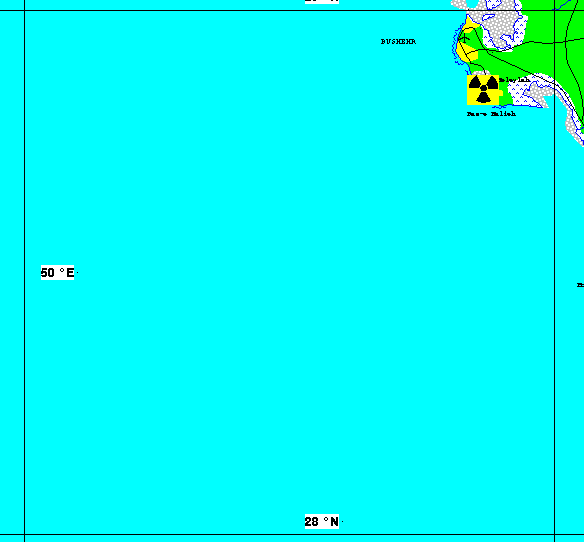




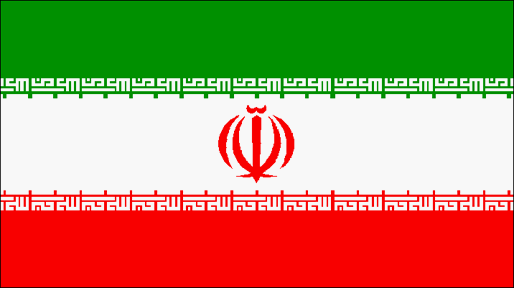
| KVR-1000 SPIN-2 Imagery |
|
| Imagery from TerraServer.com Copyright Aerial Images, Inc. and SOVINFORMSPUTNIK. Distribution and publishing in any form requires permission from Aerial Images, Inc. | |
| Click on the small image to view a larger version |
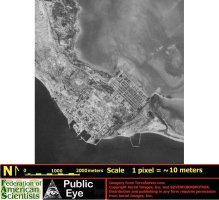
|
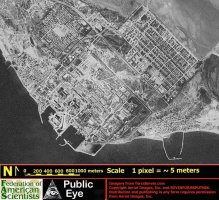
|
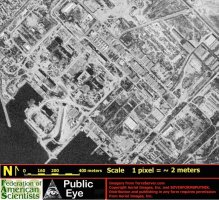
|
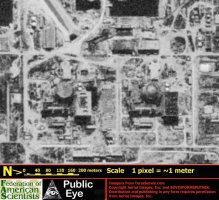
|
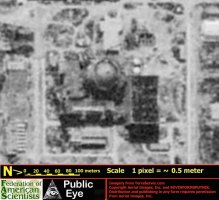
| |
In 1974 the German contractor Siemens began construction of two 1,200-1,300 megawatt electric (MWe) pressurized water nuclear reactors near Bushehr. The Shah of Iran intended that this program would provide Iran the infrastructure essential for industrializing the country.
The Siemens subsidiary Kraftwerk Union AG (KWU) had been designing and building nuclear power plants since the mid-1950s. Experience gained in the early years with different reactor types soon led to the emergence of the light water reactor as the most economical technology. From the very beginning, Siemens pursued the development of both pressurized water reactor (PWR) and boiling water reactor (BWR) plants. Beginning in the early 1970s the German government supported efforts by Siemens/KWU to secure turnkey nuclear reactor contracts in foreign markets. In 1974, Biblis A went on line in Germany: at that time the world�s largest nuclear power plant with a capacity of 1149 MW. The three 1300-MW class Convoy plants - Isar 2, Emsland and Neckar 2 - were built in Germany between 1981 and 1989.
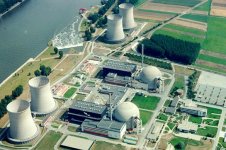
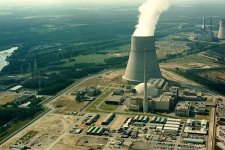
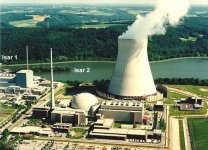
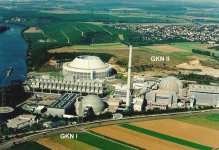


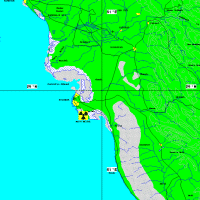
The Bushehr I reactor was 85 percent complete and the Bushehr II reactor was partially complete prior to the 1979 Iranian Revolution, after which construction of both reactors halted. Ayatollah Khomeyni declared this project "anti-Islamic," and the government of Mehdi Bazargan soon abandoned it.
During the Iran-Iraq War Iraqi strike aircraft partially damaged both reactors. Iraqi warplanes first struck the Bushehr reactor on 24 March 1984, inflicting light damage. Two more Iraqi air strikes took place in 1985, one in 1986, two in 1987, and a final raid occured in 1988. One of the reactors was severely damaged, with the structure sealed and the containment dome covered in sheet metal.
Iran sought to rebuild the Bushehr reactor, and asked the Germans to resume work on the facility. Iran was unable to persuade Siemens to resume work, in the face of diplomatic pressure applied from the United States. Kraft-Werke Union [KWU] proposeed a new design, replacing the nuclear reactors with natural gas operated turbines, but Iran was not interested in this alternative. The legal dispute between Siemens and Iran remained unresolved as of 1998. Iran claimed billions of dollars in damages based on fact that Iran had paid for a nuclear plant which was never finished. Siemens is trying to resolve the dispute, which has been supported by the International Commerce Commission in Paris.
Iran is a signatory to the Nuclear Non-Proliferation Treaty. The United States has argued that Iran has sufficient oil and gas reserves for power generation, and that nuclear reactors are expensive, unnecessary, and could be used for military purposes. Currently, Iran has five small nuclear reactors, one in Tehran and four in Isfahan. Iran claims that its nuclear power is for peaceful purposes and that it will help free up oil and gas resources for export, thus generating additional hard-currency revenues.
Nuclear power industry contacts between Iran and Russia comply with the intergovernmental agreements of 25 August 1992, on cooperation in the civil use of nuclear energy and in the construction of a nuclear power plant in Iran.
In January 1995 Russia and Iran signed a contract under which Russia would provide two VVER-1000 [aka WWER-1000] 950-1,073 MWe (electrical) light water reactors at Bushehr for payments of at least $780-million, and possibly totalling up to one billion dollars. The VVER-1000 reactor would be similar in configuration to Unit Four of the Russian Balakovskaya plant at Balakovo, Saratov. The Russian reactors will be installed in the original structures designed for the German 1,200-1,300 MWe reactors. Since the horizontal VVER-1000 steam generators are larger than the original German design, the project will require an enlargement of the existing reactor building.The agreement between Russia and Iran also calls for the spent fuel rods from the reactors to be shipped back to Russia for reprocessing to extract plutonium which could have been used by an Iranian nuclear weapons production program. Russia has consistently maintained that these light water reactors are similar to the reactors the US is providing North Korea, and cannot be used to produce weapons grade Plutonium.
The deal also called for the possible supply of two modern 465 megawatt VVER-440 reactor units, along with a centrifuge plant to enrich uranium, a 30-50 megawatt research reactor, 2000 tons of natural uranium, and technical training. The centrifuge plant was canceled under American pressure, as of 1997 the status of the research reactor and the uranium was unclear, though the training had been initiated.
On October 3, 1997, the head of Iran's Atomic Energy Agency (Gholamreza Aghazadeh, the former Oil Minister) announced that Iran would pursue a plan aimed at meeting 20% of the country's electricity demand through nuclear power. Aghazadeh said that the government had decided to build a second 1,000-megawatt (MW) unit at the Bushehr nuclear power complex as soon as work is completed on the current unit being built by the Russians. Aghazadeh further said that Iran was discussing further nuclear power plant deals with Russia and China.
According to the original contract, as many as 3,000 Russian workers would be dispatched to assist completion by 2000-2001. Russia began work on the project by May 1995 with 150 Russian technicians at the site. By March 1998 the Iranian firms working on the project's infrastructure had fallen behind schedule. In a supplement to the basic contract signed on 29 August 1998, the Russian Atomstroiexport Co. pledged to finish the construction of the Bushehr power plant on a turnkey arrangement. By the start of 1999, the partners had coordinated works to be performed to the amount of US$102 million. As many as 900 persons were employed on the site, Russian experts and workers accounting for 300 of these. According to a protocol signed in November 1998, Unit One is to be completed in May 2003. According to some estimates, the second unit might not be completed until 2007. The talks moved the Iranian party to propose three additional units to be built.
On 23 February 1998, the US State Department reaffirmed US opposition to Iran's nuclear program. The United States strongly opposes the project, which was permitted under the NPT, and has in the past provided Russia with intelligence information pointing to the existence of an Iranian nuclear weapons program. Despite this, the Russians appeared to be proceeding with work on Bushehr, with estimates as of early 1998 that the plant could be completed by 2000. On 06 March 1998, during a visit by US Secretary of State Madeleine Albright, Ukraine announced that it would not sell turbines for use with reactors at Bushehr. The contract had been worth $45 million. Five days later, Vice President Gore met with Russian Prime Minister Chernomyrdin and discussed, among other things, US concerns over Russian exports of nuclear and missile technology to Iran.
As of 29 September 2000 a pair of 1996 Russian 2-meter images and a 1998 Russian 2-meter resolution KVR-1000 images were available via the SPIN-2 service on TerraServer. Both of these images are centered on the actual location of the reactors. At least four cloud-free archived Space Imaging IKONOS 1-meter images of the Bushehr area were available on the CARTERRA� Archive, including one of the reactor location.
